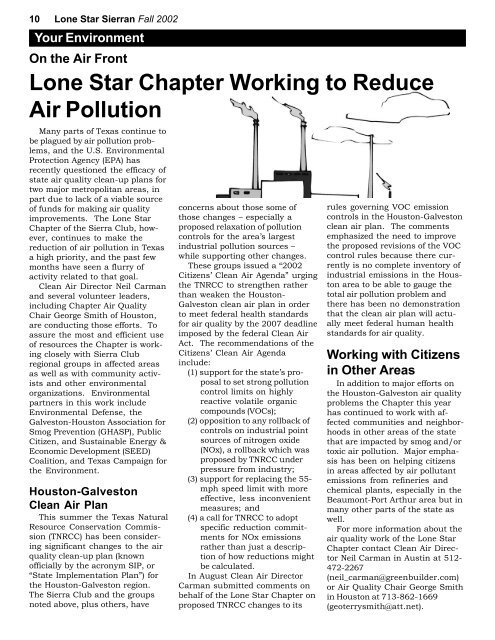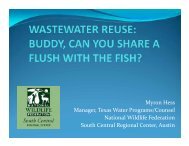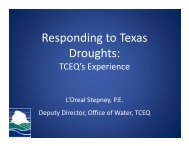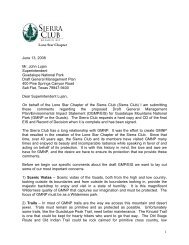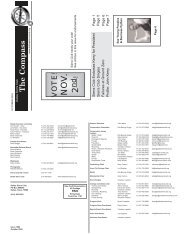Fall 2002 - Lone Star Chapter, Sierra Club
Fall 2002 - Lone Star Chapter, Sierra Club
Fall 2002 - Lone Star Chapter, Sierra Club
Create successful ePaper yourself
Turn your PDF publications into a flip-book with our unique Google optimized e-Paper software.
10 <strong>Lone</strong> <strong>Star</strong> <strong>Sierra</strong>n <strong>Fall</strong> <strong>2002</strong><br />
Your Environment<br />
On the Air Front<br />
<strong>Lone</strong> <strong>Star</strong> <strong>Chapter</strong> Working to Reduce<br />
Air Pollution<br />
Many parts of Texas continue to<br />
be plagued by air pollution problems,<br />
and the U.S. Environmental<br />
Protection Agency (EPA) has<br />
recently questioned the efficacy of<br />
state air quality clean-up plans for<br />
two major metropolitan areas, in<br />
part due to lack of a viable source<br />
of funds for making air quality<br />
improvements. The <strong>Lone</strong> <strong>Star</strong><br />
<strong>Chapter</strong> of the <strong>Sierra</strong> <strong>Club</strong>, however,<br />
continues to make the<br />
reduction of air pollution in Texas<br />
a high priority, and the past few<br />
months have seen a flurry of<br />
activity related to that goal.<br />
Clean Air Director Neil Carman<br />
and several volunteer leaders,<br />
including <strong>Chapter</strong> Air Quality<br />
Chair George Smith of Houston,<br />
are conducting those efforts. To<br />
assure the most and efficient use<br />
of resources the <strong>Chapter</strong> is working<br />
closely with <strong>Sierra</strong> <strong>Club</strong><br />
regional groups in affected areas<br />
as well as with community activists<br />
and other environmental<br />
organizations. Environmental<br />
partners in this work include<br />
Environmental Defense, the<br />
Galveston-Houston Association for<br />
Smog Prevention (GHASP), Public<br />
Citizen, and Sustainable Energy &<br />
Economic Development (SEED)<br />
Coalition, and Texas Campaign for<br />
the Environment.<br />
Houston-Galveston<br />
Clean Air Plan<br />
This summer the Texas Natural<br />
Resource Conservation Commission<br />
(TNRCC) has been considering<br />
significant changes to the air<br />
quality clean-up plan (known<br />
officially by the acronym SIP, or<br />
“State Implementation Plan”) for<br />
the Houston-Galveston region.<br />
The <strong>Sierra</strong> <strong>Club</strong> and the groups<br />
noted above, plus others, have<br />
concerns about those some of<br />
those changes – especially a<br />
proposed relaxation of pollution<br />
controls for the area’s largest<br />
industrial pollution sources –<br />
while supporting other changes.<br />
These groups issued a “<strong>2002</strong><br />
Citizens’ Clean Air Agenda” urging<br />
the TNRCC to strengthen rather<br />
than weaken the Houston-<br />
Galveston clean air plan in order<br />
to meet federal health standards<br />
for air quality by the 2007 deadline<br />
imposed by the federal Clean Air<br />
Act. The recommendations of the<br />
Citizens’ Clean Air Agenda<br />
include:<br />
(1) support for the state’s proposal<br />
to set strong pollution<br />
control limits on highly<br />
reactive volatile organic<br />
compounds (VOCs);<br />
(2) opposition to any rollback of<br />
controls on industrial point<br />
sources of nitrogen oxide<br />
(NOx), a rollback which was<br />
proposed by TNRCC under<br />
pressure from industry;<br />
(3) support for replacing the 55-<br />
mph speed limit with more<br />
effective, less inconvenient<br />
measures; and<br />
(4) a call for TNRCC to adopt<br />
specific reduction commitments<br />
for NOx emissions<br />
rather than just a description<br />
of how reductions might<br />
be calculated.<br />
In August Clean Air Director<br />
Carman submitted comments on<br />
behalf of the <strong>Lone</strong> <strong>Star</strong> <strong>Chapter</strong> on<br />
proposed TNRCC changes to its<br />
rules governing VOC emission<br />
controls in the Houston-Galveston<br />
clean air plan. The comments<br />
emphasized the need to improve<br />
the proposed revisions of the VOC<br />
control rules because there currently<br />
is no complete inventory of<br />
industrial emissions in the Houston<br />
area to be able to gauge the<br />
total air pollution problem and<br />
there has been no demonstration<br />
that the clean air plan will actually<br />
meet federal human health<br />
standards for air quality.<br />
Working with Citizens<br />
in Other Areas<br />
In addition to major efforts on<br />
the Houston-Galveston air quality<br />
problems the <strong>Chapter</strong> this year<br />
has continued to work with affected<br />
communities and neighborhoods<br />
in other areas of the state<br />
that are impacted by smog and/or<br />
toxic air pollution. Major emphasis<br />
has been on helping citizens<br />
in areas affected by air pollutant<br />
emissions from refineries and<br />
chemical plants, especially in the<br />
Beaumont-Port Arthur area but in<br />
many other parts of the state as<br />
well.<br />
For more information about the<br />
air quality work of the <strong>Lone</strong> <strong>Star</strong><br />
<strong>Chapter</strong> contact Clean Air Director<br />
Neil Carman in Austin at 512-<br />
472-2267<br />
(neil_carman@greenbuilder.com)<br />
or Air Quality Chair George Smith<br />
in Houston at 713-862-1669<br />
(geoterrysmith@att.net).


